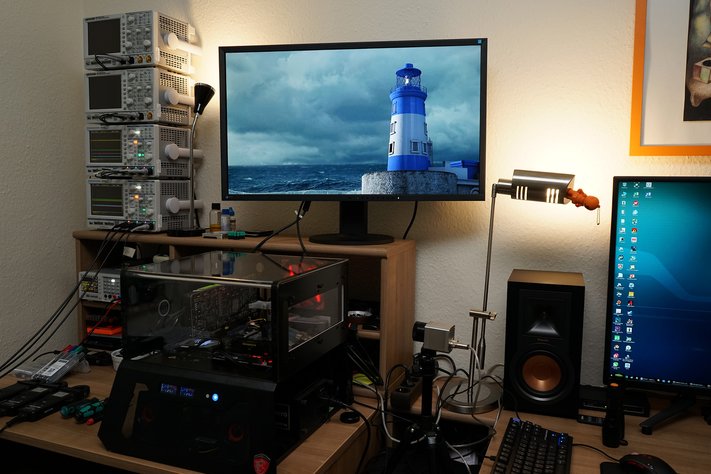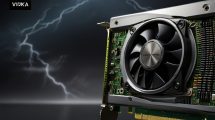In direct competition, the GeForce GTX 1070 Ti must of course compete primarily with the Radeon RX Vega 56. In addition, we are also 100% sure that players also want to know how the GeForce GTX 1070 Ti beats the faster and more expensive GeForce GTX 1080 and the GeForce GTX 1080 Ti. That's why we include them in our benchmark results. We'll also add the GeForce GTX 1070 to complete the Pascal-based hardware. AMD's Radeon RX Vega 64 is not to be missed.
The GeForce GTX 1070 Ti used for our game tests is the GeForce GTX 1070 Ti Titanium 8G from MSI. The performance should be representative of Nvidia's Founders Edition Board or any other standard-clock partner card, as they all ship uniformly. Since our test samples of the Founders Edition also came very late this time, there was only time for random plausibility tests in the individual benchmarks. And they have been able to fully confirm this statement.
Comparison maps
- MSI GeForce GTX 1070 TI Titanium 8G
- Nvidia GeForce GTX 1080 TI FE
- Nvidia GeForce GTX 1080 FE
- Nvidia GeForce GTX 1070 FE
- AMD Radeon RX Vega64
- AMD Radeon RX Vega56
Software and drivers
In the run-up to today's review, we have completely redesigned the software suite of our platform. Installing the Windows 10 Creators update caused all sorts of problems with PresentMon, OCAT and our own custom front end, but we thought it was important to keep our operating systems up to date.
As a result, we used a combination of OCAT 1.1.0 and PMG 0.9.21 to collect the required data or to collect the required data. (Performance In DirectX, OpenGL and Volcano), along with a new build of our own log file interpreter to take this information into Excel. All Nvidia cards were compared to driver versions 388.00 and 388.09, while AMD's cards were tested with the current Crimson ReLive Edition 17.10.3.
- Ashes of the Singularity: Escalation
- Battlefield 1
- Destiny 2
- Doom
- Metro: Last Light Redux
- Middle-earth: Shadow of War
- Rise of the Tomb Raider
- Tom Clancy's The Division
- Tom Clancy's Ghost Recon Wildlands
- The Witcher 3
- Warhammer 40,000: Dawn of War III.
Test
The new test system and the methodology have already been described in great detail in the basic article "How We Test Graphics Cards" (English: "How We Test Graphics Cards") and therefore, for the sake of simplicity, we now only refer to this detailed Description. So if you want to read everything again, you are welcome to do so. However, we have improved CPU and cooling once again in order to largely exclude possible CPU bottle necks for this fast card.

If you are interested, the summary in table form quickly provides a brief overview:
| Test systems and measuring rooms | |
|---|---|
| Hardware: |
Germany Intel Core i7-6900K x 4.3 GHz MSI X99S XPower Gaming Titanium Corsair Vengeance DDR3-3200 1x 1TB Toshiba OCZ RD400 (M.2, System) 2x 960GB Toshiba OCZ TR150 (Storage, Images) be quiet! Dark Power Pro 11, 850W Power Supply Windows 10 Pro (Creators Update)U.S. Intel Core i7-7700K MSI Z270 Gaming Pro Carbon G.Skill F4-3200C14Q-32GTZ 1x 500GB Crucial MX200 be quiet! Dark Power Pro 11, 850W Power Supply Windows 10 Pro (Creators Update) |
| Cooling: |
Alphacool Ice Block XPX Alphacool Ice Age 2000 Chiller 2x Be Quiet! Silent Wings 3 PWM (Closed Case Simulation) Thermal Grizzly Kryonaut (for cooler change) |
| Housing: |
Lian Li PC-T70 with expansion kit and modifications Modes: Open Benchtable, Closed Case |
| Monitor: | Eizo EV3237-BK |
| Power consumption: |
non-contact DC measurement on the PCIe slot (Riser-Card) non-contact DC measurement on the external PCIe power supply Direct voltage measurement on the respective feeders and on the power supply 2x Rohde & Schwarz HMO 3054, 500 MHz multi-channel oscillograph with memory function 4x Rohde & Schwarz HZO50, current togor adapter (1 mA to 30 A, 100 KHz, DC) 4x Rohde & Schwarz HZ355, touch divider (10:1, 500 MHz) 1x Rohde & Schwarz HMC 8012, digital multimeter with storage function |
| Thermography: |
Optris PI640, infrared camera PI Connect evaluation software with profiles |
| Acoustics: |
NTI Audio M2211 (with calibration file) Steinberg UR12 (with phantom power for the microphones) Creative X7, Smaart v.7 own low-reflection measuring room, 3.5 x 1.8 x 2.2 m (LxTxH) Axial measurements, perpendicular to the center of the sound source(s), measuring distance 50 cm Noise in dBA (Slow) as RTA measurement Frequency spectrum as a graph |
- 1 - Übersicht und Testsystem
- 2 - Testsystem und -methodik
- 3 - Im Detail: Nvidia GeForce GTX 1070 Ti FE
- 4 - Im Detail: MSI GeForce GTX 1070 Ti Titanium
- 5 - Ashes of the Singularity: Escalation (DirectX 12)
- 6 - Battlefield 1 (DirectX 12)
- 7 - Destiny 2 (DirectX 11)
- 8 - Doom (Vulkan)
- 9 - Metro: Last Light Redux (DirectX 11)
- 10 - Middle-earth: Shadow of War (DirectX 11)
- 11 - Rise of the Tomb Raider (DirectX 12)
- 12 - Tom Clancy’s Ghost Recon Wildlands (DirectX 11)
- 13 - Tom Clancy’s The Division (DirectX 12)
- 14 - Warhammer 40,000: Dawn of War III (DirectX 11)
- 15 - The Witcher 3 (DirectX 11)
- 16 - Leistungsaufnahme im Detail
- 17 - Temperaturen und Takt
- 18 - Übertaktung
- 19 - Lüfterdrehzahlen und Geräuschentwicklung
- 20 - Zusammenfassung und Fazit
































Kommentieren